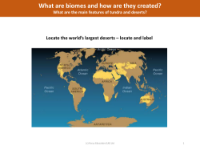What are the main features of the tundra and deserts? - Presentation

Geography Resource Description
The tundra and desert biomes are two of the Earth's most extreme environments, each with distinct characteristics that define their landscapes and the life they support. Tundras are characterised by their cold and icy conditions, with long winters where temperatures can plummet to -20 to -30°C, and short, cool summers with average temperatures around 5°C. This biome experiences significant temperature variations and frequent strong winds, along with limited rainfall. The tundra is bathed in continuous daylight during summer, known as "the land of the midnight sun," but endures periods of complete darkness in winter. The soil in tundras, known as permafrost, is permanently frozen, limiting drainage and leading to marshy surfaces. Vegetation is simple and sparse, with plants like dwarf shrubs, grasses, mosses, and lichens that have adapted to the harsh conditions. Despite the tough environment, a variety of animals, including caribou, Arctic hares, and polar bears, call the tundra home, many of which migrate or adapt significantly to survive the extreme climate.
Deserts, in contrast, are defined by their aridity, receiving less than 10 inches of rain annually. They can be hot, like the Sahara, the largest hot desert on Earth, or cold, such as Antarctica, the largest cold desert. Despite the harsh, dry conditions, deserts are home to a range of specially adapted plants and animals. During the day, temperatures can soar to 38°C, while at night they may drop to -4°C, resulting in a significant diurnal temperature range. Vegetation is typically limited to hardy shrubs and cacti, while animals such as lizards, rattlesnakes, and coyotes have evolved to be predominantly nocturnal to escape the daytime heat. Deserts can vary greatly in their surface composition, from sandy to rocky to snow-covered, and cover approximately 20% of the world's land surface. Both biomes present unique challenges for survival, demanding remarkable adaptations from their inhabitants.








